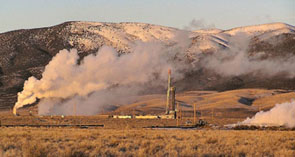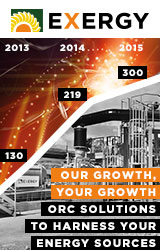Case Study: EGS Technology Demonstration & the Idaho Geothermal Power Project
 Case history
Case history
During the 1970s, the Department of Energy (DOE) was mandated to develop new non-petroleum sources of domestic energy. Raft River, Idaho, 200 miles southeast of Boise, was selected as a site for DOE research because of its hot geothermal water. From 1975 to 1983, $40 million was spent on wells, injectors, and other infrastructure to test binary cycle power technology and experiment with direct uses of geothermal fluid for agriculture and aquaculture.
This was a landmark achievement as the world’s first binary power plant was developed. It had a capacity of seven megawatts (MW). Binary cycle technology proved at the time that electricity could be generated from moderate-temperature geothermal reservoirs (212° F or 100° C to 572° F or 300° C). DOE sold the site in 1984 when project funding ended. But as population increased in the western states, so did the demand for electricity. Technology improvements and reduced cost of geothermal power, combined with volatility in the natural gas market, led to increased interest in geothermal resources.
Binary geothermal power
Binary geothermal power plants have grown in the western United States and the world. With binary technology, hot geothermal water passes through a heat exchanger and heats a binary liquid called isopentane, which boils and vaporizes at a lower temperature and creates higher pressure than water. The vapor produced from the binary liquid spins the turbine-generator unit, and then it’s condensed back to liquid before being re-used in the heat exchanger. After a portion of the heat is used from the geothermal water, it exits the binary plant and is injected back into the reservoir.
In 2003, financing became available to develop Raft River. By 2005, a 20-year power purchase agreement was signed with Idaho Power Company, and the first commercial-scale binary power plant in Idaho was developed with a nameplate production capacity of 15.8 MW. Commercial operations began in January of 2008.
In June 2010, two production wells were shut down; however, a Repair Services Agreement was signed in May of this year to repair the wells. This presented an opportunity to demonstrate the effectiveness of a new type of geothermal power called Enhanced Geothermal Systems (EGS).
The DOE is currently providing funding in a cost-sharing arrangement. Scientific data and an existing test well are the non-cash, in-kind contribution to this project.
Until recently, geothermal power systems have used resources where naturally occurring heat, water, and rock permeability allow energy extraction from production wells. However, the vast majority of geothermal energy within reach of conventional techniques is in dry and/or non-permeable rock. EGS technologies enhance and/or create geothermal resources in this hot, dry rock (HDR) through hydraulic, thermal, and chemical processes, as well as stimulation causing fractures that have been sealed to open, extend, and interconnect.
Demonstration environment
Raft River’s favorable characteristics make it ideal for testing. It has abundant, accessible, and moderate temperature resources at shallow to intermediate depths. It’s also located within the MIT-designated High Grade EGS Area of North America, and is a favorable rock and stress environment with rock temperatures of 392° F or 200° C within 4.5 kilometers in depth. With an existing transmission and power generation infrastructure, it has a proven reservoir that may provide fluid for a deep system.
As part of this project, the reservoir will be pre-conditioned and thermally fractured using low-temperature water injection in a series of staged simulation treatments. Earlier testing indicates injection of cool water can significantly enhance injectivity. Seismic activity will also be measured and modeled.
Advantages of geothermal project demonstration
• Development of new technology expected to lead to lower costs for future reservoir development and increased power generation;
• EGS/HDR technologies are distinct from hydrothermal geothermal systems in that they may be shown to be feasible anywhere in the world, depending on the economic limits of drill depth;
• HDR wells are expected to have a useful life of 20 to 30 years before the outflow temperature drops 10° C, and no longer has the economic benefit;
• Project builds on expertise from the geothermal, oil, and gas industries;
• New geothermal scientists are being trained; and
• The 2011 Geothermal Energy Association report states the geothermal industry is producing clean power in nine states: Alaska, California, Hawaii, Wyoming, Idaho, Nevada, and New Mexico, Oregon and Utah and developing 146 projects across 15 states.
Conclusion
Testing of EGS reservoir development is currently lacking in this country, so Raft River will again be at the forefront of geothermal exploration with demonstrations expected to substantiate the range of possibilities for use of these valuable resources in the United States.
Gloria Mabbutt is part of the Division of Marketing and Communications for Idaho Department of Commerce.
Idaho Department of Commerce
www.idaho.commerce.gov
Author: Gloria Mabbutt
Volume: July/August 2011











